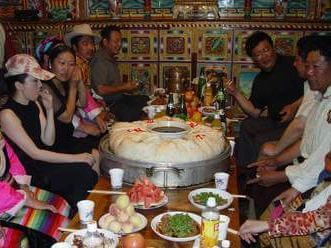Batang Tuanjie steamed stuffed bun

The Tuanjie steamed bun was not invented by the 18th army when it entered Batang. In the old days, Tuanjie steamed bun, to be exact, was made by Batang ancestors hundreds of years ago. Moreover, it has been handed down to the present day. Before liberation, the ingredients needed for making Tuanjie steamed bun were numerous and expensive. Due to economic conditions and material shortage at that time, most families did not dare to "favor" it It was enjoyed by a very small number of wealthy people, so it was insignificant in the past.
Batang Tuanjie steamed buns are determined by the number of people who eat. If there are many people who have a meal together, they will lay enough flour to make a big steamed bun, which means that everyone will be satisfied. On festivals, or when classmates, friends and relatives get together, they will make a united steamed stuffed bun. When eating Tuanjie steamed buns, people sit around and put Tuanjie steamed stuffed buns with steaming heat and strong fragrance in the middle of the table, and then put a small plate in front of each person, which is filled with water. In addition, we also need to make a pot of thick butter tea. This is the second characteristic of Tuanjie baozi: national characteristics. At the same time, it is also the integration of Tibetan and Han ethnic food culture (Tibetan Chinese food method, Tibetan Chinese concoction, Tibetan Han meal).
"Tuanjie baozi" has another feature because of its variety of fillings: multi-functional. Stuffing can be beef, pork, rice flour, corn flour, potato chips, etc. Therefore, it can be served with wine, can be served as a meal, can also be used as a meal to welcome relatives and friends. Especially in the traditional folk entertainment of Batang people, "Tuanjie baozi" is more attractive. It is easy to make, suitable for all ages, and the food is cooked together. It is fragrant, pleasant and delicious.

-
2.Muzhaling Luoyang
Located in Checun Town, Songxian County, Luoyang City, Henan Province, Luoyang Muzhaling is a National Nature Reserve of Funiu Mountain and a world geological park.
Time 2019-02-06 -
3.Qixia Mous Manor
Mou's Manor, also known as Mou Erhei Manor, is located in Ducun, an ancient town in the north of Qixia City (the northern head of the original Xiaguang Third Road).
Time 2019-02-07 -
4.Eight dishes
Eight-flavor dish is a delicacy, the main ingredients are green pepper, 1000 grams; soybean, 1000 grams; head vegetables, 3000 grams; sugar, 250 grams; vinegar, 250 grams; salt, 250 grams; soy sauce,
Time 2019-03-27 -
5.Spring Festival
The Spring Festival, the Lunar New Year, is the first year of the year and also the traditional "New Year's Day". Commonly known as New Year, Spring Festival has a long history
Time 2019-04-22 -
6.Sanhui Pavilion Club
Sanhui Caiting Pavilion is a local traditional folk cultural activity that performs in streets or squares on March 16-18 of the lunar calendar every year. Its artistic form of performance is ingenious
Time 2019-06-12 -
7.Xi an Drums Music
Xi'an drum music, also known as Chang'an ancient music. It is a large-scale traditional folk drum music spread in Xi'an (ancient Chang'an) and its surrounding areas for thousands of years. It originat
Time 2019-06-30 -
8.Yongan Daqiang Opera
Yongan Daqiang Opera was formed in the mid-Ming Dynasty. It is a genre of Yiyang Opera. It is called Daqiang Opera because it is "big gong, big drum and big voice singing high tune". During
Time 2019-07-14 -
9.Southwest Minzu University
Make great efforts, and the years will be golden. Southwest University for Nationalities is located in Chengdu, a famous historical and cultural city with the reputation of "the kingdom of heaven
Time 2019-08-31 -
10.Lao Tzu
Laozi, surnamed Li Minger, is a character of Bai Yang, or posthumous Bo Yang. In the late spring and Autumn period, the birth and death years were unknown. About 571 years ago, it was born in the late
Time 2019-09-04 -
11.Cao Mao
Cao Mao (241 November 15th - 260 June 2nd) Zi Yan, Pei County, Yuzhou City. Anhui Province Bozhou City People, the Three Kingdoms period the Wei state of the Three-Kingdoms Period The fourth emperors
Time 2019-09-15 -
12.Giant Sleeping Buddha
The giant Sleeping Buddha is located in Leshan City, Sichuan Province. In the periphery of Leshan Giant Buddha, there is a "giant Sleeping Buddha" with a total length of more than 4000 meters and composed of several mountains.
Time 2020-10-15